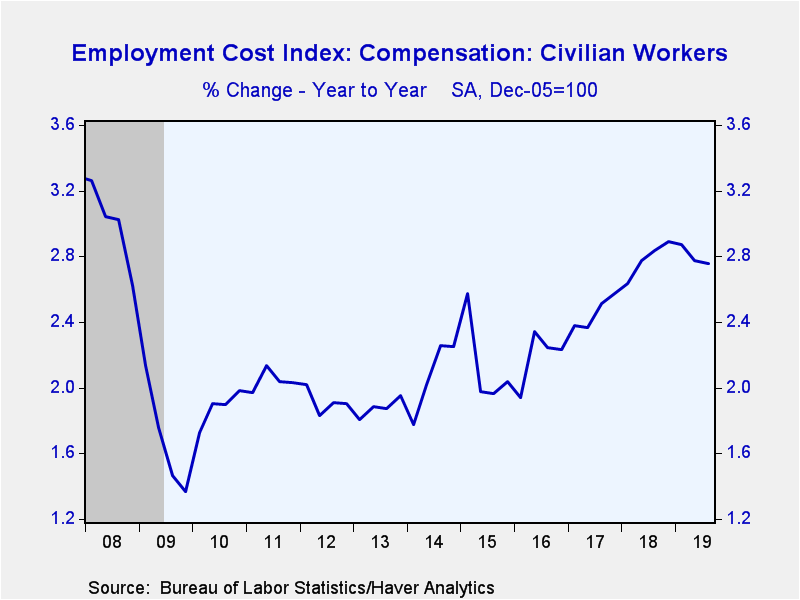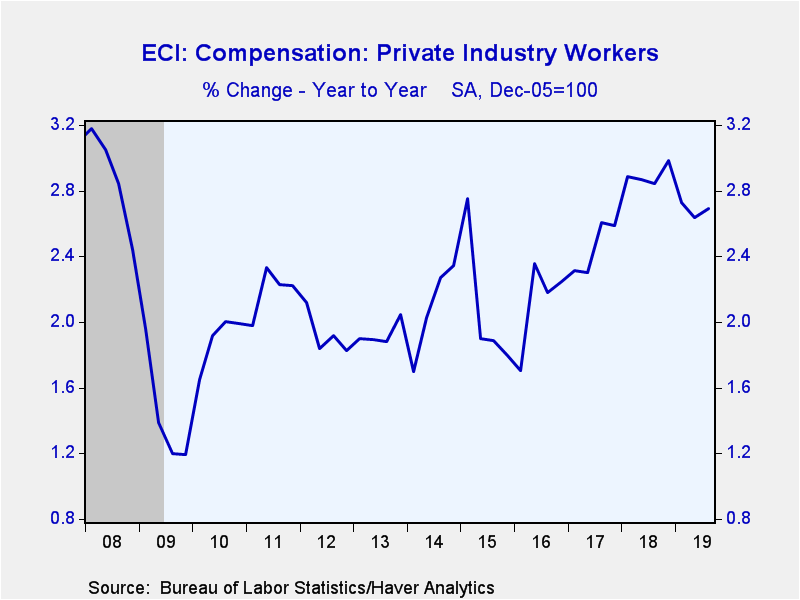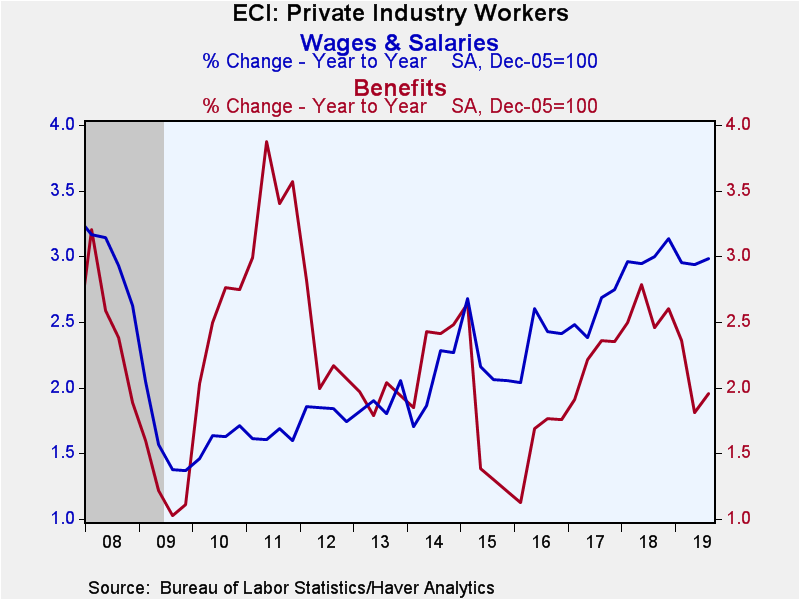 Global| Oct 31 2019
Global| Oct 31 2019Rise in U.S. Employment Costs Quickens in Q3
by:Sandy Batten
|in:Economy in Brief
Summary
The employment cost index (ECI) for civilian workers rose 0.7% q/q in 2019 Q3, up from a 0.6% quarterly rise in Q2. This was spot on market expectations from the Action Economics Forecast Survey. The y/y growth of total compensation [...]
The employment cost index (ECI) for civilian workers rose 0.7% q/q in 2019 Q3, up from a 0.6% quarterly rise in Q2. This was spot on market expectations from the Action Economics Forecast Survey. The y/y growth of total compensation was unchanged at 2.8% in Q3, down from 2.9% in 2018 Q4 and 2019 Q1. Wage and salaries jumped up 0.9% q/q (2.9% y/y) in Q3 versus 0.7% q/q in Q2 while benefits for civilian workers picked up, rising 0.6% q/q (2.4% y/y) in Q3 versus 0.5% in Q2. Civilian workers include those in private industry and in state and local governments, but not in the federal government.
Total compensation gains in private industry quickened even more in Q3, rising 0.8% q/q (2.7% y/y) versus 0.5% q/q in Q2. This was the fastest pace of quarterly advance since 2018 Q3. The pickup in quarterly compensation growth in Q3 was concentrated in services-producing industries though the pace of compensation gains rose in both. Compensation in goods production increased 0.8% q/q, up marginally from 0.7% in Q2. Compensation in service production jumped 0.8% q/q in Q3 after having slowed sharply to 0.5% q/q in Q2. In contrast to the quarterly pattern, the y/y pace of service-producing compensation was unchanged at 2.7% in Q3 while the y/y pace for goods producing jobs jumped up to 3.0% in Q3 (the fastest annual pace since 2008 Q1) from 2.4% in Q2.
Wage and salary gains within private industry accelerated to 0.9% q/q (3.0% y/y) in Q3 from 0.6% in Q2. The quarterly pickup was led by growth in goods production, where wages rose 1.0% q/q in Q3 versus 0.7% in Q2. Wages in service production also posted a solid increase, rising 0.8% q/q in Q3versus 0.6% in Q2. Manufacturing wage growth was unchanged at 0.7% q/q in Q3 while wages in construction jumped up 1.4% q/q in Q3 after a 0.9% rise in Q2.
Private industry benefits growth rose slightly to 0.5% q/q in Q3 from a 0.4% q/q rise in Q2 with the y/y pace picking up to 2.0% from 1.8%. Annual growth in benefits in goods-producing sectors shot up to 2.3% in Q3 from 1.5% in Q3 while annual growth of service-producing benefits was unchanged at 1.9%.
The employment cost index figures are available in Haver's USECON database. Consensus estimates from the Action Economics survey are in Haver's AS1REPNA database.
Sandy Batten
AuthorMore in Author Profile »Sandy Batten has more than 30 years of experience analyzing industrial economies and financial markets and a wide range of experience across the financial services sector, government, and academia. Before joining Haver Analytics, Sandy was a Vice President and Senior Economist at Citibank; Senior Credit Market Analyst at CDC Investment Management, Managing Director at Bear Stearns, and Executive Director at JPMorgan. In 2008, Sandy was named the most accurate US forecaster by the National Association for Business Economics. He is a member of the New York Forecasters Club, NABE, and the American Economic Association. Prior to his time in the financial services sector, Sandy was a Research Officer at the Federal Reserve Bank of St. Louis, Senior Staff Economist on the President’s Council of Economic Advisors, Deputy Assistant Secretary for Economic Policy at the US Treasury, and Economist at the International Monetary Fund. Sandy has taught economics at St. Louis University, Denison University, and Muskingun College. He has published numerous peer-reviewed articles in a wide range of academic publications. He has a B.A. in economics from the University of Richmond and a M.A. and Ph.D. in economics from The Ohio State University.










